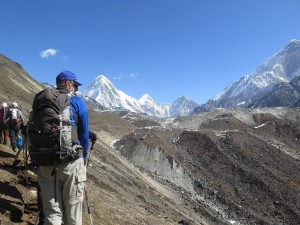Climbing Mount Everest next month will be incredibly challenging. But, my three previous trips to the Himalayas have shown me that just getting to the mountains can be difficult. If you want to climb a big mountain in Nepal, you must first trek there. While trekking (hiking) is not usually technically difficult it demands huge amounts of tolerance and tenacity.
Trekking Tolerance
Trekking along a rushing river and seeing its’ magnificent geologic handicraft is a visual treat. Avalanche scars flank villages where century old terraces allow families to till small gardens of potatoes and barley. Waterfalls drape the valley sidewalls, and whitewater swirls beneath your feet as you warily cross steel suspension bridges over the roaring Dudh Kosi (Milk River).
![IMG_1190[1]](https://www.speakingofadventure.com/wp-content/uploads/2015/04/IMG_11901-300x225.jpg) But to access this beauty you must tolerate many things. Just flying to our starting point in Lukla demanded three trips to the airport, before the clouds parted and we were able to get into the valley. In the mountains, life moves at a different pace, so time is different. Better put your precise schedule away unless you want to make yourself unnecessarily aggravated over how long some things seem to take.
But to access this beauty you must tolerate many things. Just flying to our starting point in Lukla demanded three trips to the airport, before the clouds parted and we were able to get into the valley. In the mountains, life moves at a different pace, so time is different. Better put your precise schedule away unless you want to make yourself unnecessarily aggravated over how long some things seem to take.
The remoteness of this Himalayan valley means that resources and supplies are limited, and they are subject to change at any time. Savvy trekkers soon develop a calm tolerance for whatever comes their way. Yaks and human porters move every supply through the valley, so you need to step aside and let them through, even if that means you step into a mud puddle, or worse!
All of these minor issues should be known to a trekker before they arrive, so they aren’t problems. They are opportunities for you to work on your own tolerance. If you let these things annoy you, then you will turn your own trek unpleasant. Having calm tolerance for all these crazy little moments allows you to enjoy yourself while soaking in what it means to live and trek through the Khumbu Valley.
Tenacity for Gaining Altitude
Trekking anywhere in Nepal requires hiking lateral miles, of course, but more importantly, it means going up and down. Drawing lines on a topographic map might indicate that the trek from Lukla to Everest base camp is about forty miles and requires ascending about 8,500 feet. In fact, the many valleys and side hills mean that you must ascend and descend, over and over again. Combine this with the ever-thinning atmosphere as we rise higher, and the average Khumbu trekker takes about 9 to 11 days to reach the foot of Mount Everest.
While a fit trail runner might be able to cover the ground in less than a day, that is a formula for altitude sickness. Ascending more than 2,000 feet per day on average will likely lead to acute mountain sickness, including headaches, lethargy and more. If you try going up even faster, you can get slammed with deadly cerebral edema or pulmonary edema. It happens to over-anxious trekkers every season.
Along the way, trekkers will also encounter:
– unsettled stomachs (new foods, microbes, bad water, etc.)
– gastrointestinal infections
– rough living conditions
Pile all this on top of an already weary traveler, and you can see how it takes significant tenacity just to traverse the valley to Mount Everest.
On our journey up valley, my teammates and I have collectively had: headaches, colds, stomach aches, diarrhea, and two types of bed bug bites! Sounds like fun, eh?
Two basic attributes have gotten us this far: tolerance and tenacity. Ten days of steady efforts have landed our team in a sunny side valley at 15,800 feet. After a rest day today, tomorrow will be the final leg of our trek. We will stride along the dusty rock debris of the moraine hills that flank the Khumbu Glacier. By day’s end, the moment I dreamed of for years will be here: We will arrive at Everest base camp.
Reaching the foot of Everest will not be a finish line though; it will be the starting line. We will begin an even bigger journey. Ahead of us is a 40-day challenge that will make the minor travails of the approach trek pale in comparison. When our trek concludes tomorrow, we can start climbing Mount Everest.
Stay resilient.
– Jim

Jim this all sounds awesome except for the “bed bug bites!” Enjoy every second of your time there.
Thank you Jim for giving us a glimpse into your amazing journey. Good luck and safe travels as you begin another phase of your trekke up Everest!